Thursday Oct. 4, 2007
Quiz #2 is next week (Thu., Oct. 11). A preliminary online
version of the Quiz #2 Study Guide is now
available. Reviews will be held Tuesday and Wednesday afternoons
next week (you are welcome also to attend the Monday afternoon review
which is norminally for the MWF section of the class).
Optional Assignment #2 will be returned next Tuesday. Answers
will
appear online sometime today or tomorrow.
Optional Assignment #3 will be due at the beginning of class next
Tuesday.
We
will be studying energy balance on the earth with an atmosphere
today. The greenhouse effect is a big part of this and we should
learn more about how that works today. First we will quickly
review what we covered last Tuesday.
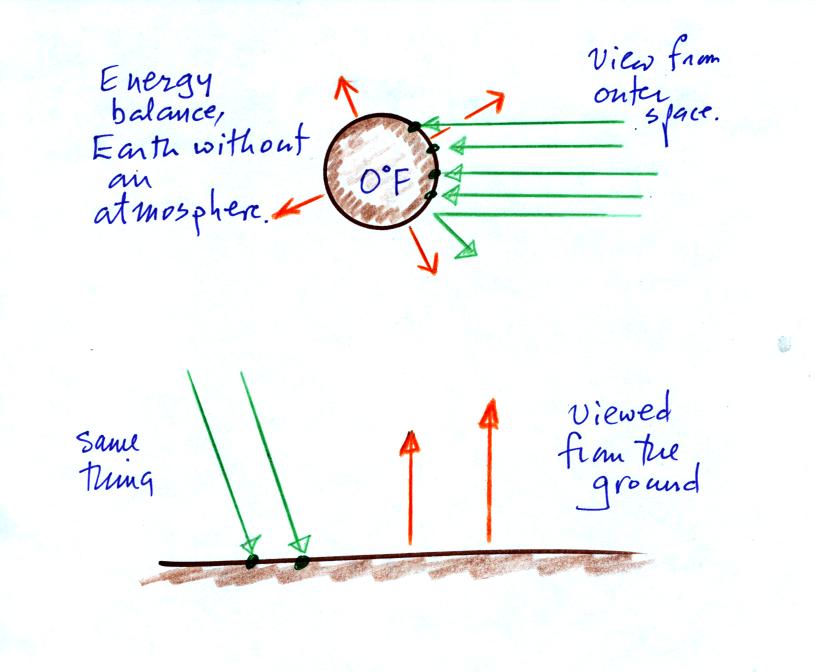
The top figure shows energy balance on the earth viewed from a
vantage point in outer space. Five rays of sunlight arrive at the
earth. Four rays are absorbed, one is reflected. The
reflected ray doesn't really play a role in energy balance, it's as if
that ray wasn't even there. To be in energy balance the earth
must emit 4 rays of energy.
The lower figure above (see p. 70a in the photocopied Class Notes)
shows energy balance viewed from the ground. Two rays of incoming
sunlight are balanced by 2 rays of emitted radiation. The
temperature of radiative equilibrium (temperature of the earth's
surface) is about 0 F for this case. There's nothing special
about the fact that two rays are drawn, it could have been 3 or
4. The important detail is that absorbed energy is balanced by an
equal amount of emitted energy.
Today we will be adding an atmosphere to the lower figure above.
We need to know how the atmosphere will affect the incoming sunlight
(a mixture of UV, visible, and IR light) and also the radiation emitted
by the earth (IR light).
We will first look at the effect simple blue,
green, and red glass
filters have on visible light.

If you try to shine white light (a mixture of all the colors) through a
blue filter, only the blue light passes through.
0% absorption on an absorption curve means the filter
behaves like a window
made of clear glass, the filter is transparent to light. The
light
can
pass freely through the filter. 100% absorption on the other
hand
means the filter is opaque, it blocks the light by
absorbing it. The blue filter
absorption curve shows 100% absorption at all but a narrow range of
wavelengths that correspond to blue light. Similarly the green
and red filters only let through green and red light. Note how
the slot in the absorption curve shifted to higher wavelengths for the
green and red filters.
The following figure is a simplified easier to remember
representation of the
filtering effect of
the atmosphere on UV, VIS, and IR light (found on p. 69 in the
photocopied notes)

In our simplified representation oxygen and ozone make the
atmosphere a
pretty good absorber of UV light The atmosphere is pretty nearly
perfectly
transparent to VIS light (we can check this out with our eyes, we can
see through the air, it is clear).
Greenhouse gases make the
atmosphere a
selective absorber of IR light - it absorbs certain IR wavelengths and
transmits others. It is the atmosphere's ability to absorb (and
also emit) certain wavelengths of infrared light that produces the
greenhouse effect and warms the surface of the earth.
Note "the atmospheric window"
centered at 10 micrometers. Light emitted by the earth at this
wavelength will pass through the atmosphere. Another transparent
region, another window, is found in the visible part of the spectrum.
The following figure found at the top of p. 70 in the photocopied Class
Notes is a more realistic filter absorption for the atmosphere.

Now we
will look at a very simplified explanation of the greenhouse
effect. You'll find it on p. 70b in the photocopied Class Notes
(you might keep p. 70a nearby for comparison). We will examine
this figure one little part at a time.

The figure shows two rays of incoming sunlight that
pass through the atmosphere, reach the ground, and are absorbed.
100% of the incoming sunlight is transmitted by the atmosphere (this is
not a very realistic assumption).
The ground is emitting 3 rays of IR radiation.

One of these is emitted by the ground at a wavelength that is
NOT absorbed by greenhouse gases in the atmosphere. This
radiation passes through the atmosphere and goes out into space.
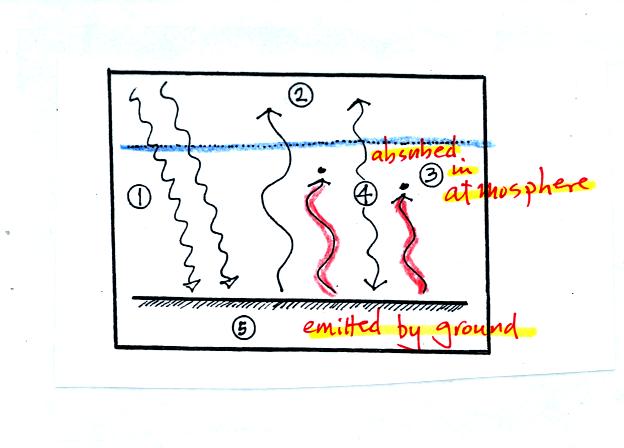
The other 2 units of IR radiation emitted by the ground are
absorbed by
greenhouse gases is the atmosphere.
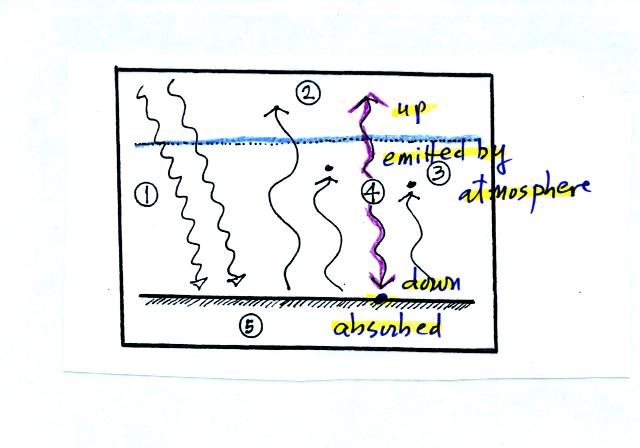
The atmosphere is absorbing
2 units of radiation.
In order to be in radiative equilibrium,the atmosphere must also emit 2
units of radiation. 1
unit of IR radiation is sent upward into space, 1 unit is sent downward
to the ground where it is absorbed.

The greenhouse effect is found in this absorption and emission
of IR radiation by the atmosphere. We tried to put into words
what is illustrated above:

Before we go any further we will check to be sure that
every part
of this picture is in energy balance.

The ground is absorbing 3 units of energy and emitting
3
units of energy

The atmosphere is absorbing 2 units of energy and emitting 2
units of
energy

2 units of energy arrive at the earth from outer space, 2 units
of
energy leave the earth and head back out into space.
Here's the first of this semester's hidden
optional assignments.
The
greenhouse effect makes the earth's surface warmer than it would be
otherwise.

Energy balance with (right) and without (left) the
greenhouse
effect. At left the ground is emitting 2 units of energy, at
right the ground is emitting 3 units. Remember that the amount of
energy emitted by something depends on temperature. Warm ground
will emit more energy than colder ground.
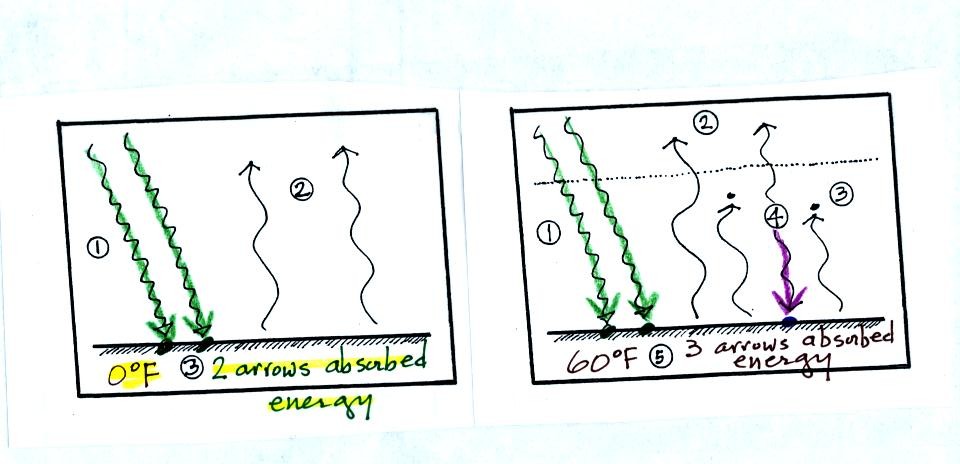
Here's another explanation. At left the ground
is getting 2 units of energy. At right it is getting three, the
extra one is coming from the atmosphere. Doesn't it make sense
that ground that absorbs 3 units of energy will be warmer than ground
that is only absorbing 2.
Next
we will look at how realistic our simplifying assumptions are.

In our simplified version of the greenhouse
effect we
assumed that
100%
of the sunlight arriving at the top of the atmosphere passes through
the atmosphere and gets absorbed by the ground. The bottom figure
above shows that in reality only about 50% of the incoming sunlight
gets absorbed at the ground.
About 20% of the incoming sunlight is absorbed by gases in the
atmosphere. Sunlight is a
mixture of UV, VIS, and IR light.
Ozone and oxygen will absorb a lot of the UV (though there isn't much
UV in sunlight) and greenhouse gases will absorb some of the IR
radiation in sunlight (IR light accounts for about half of the light in
sunlight).
The remaining 30% of the incoming sunlight is reflected back into space
(by the ground, clouds, even air molecules).
At the top of the figure below we see our simplified explanation of the
greenhouse effect. You should be able to exlain what each of these
arrows represents.
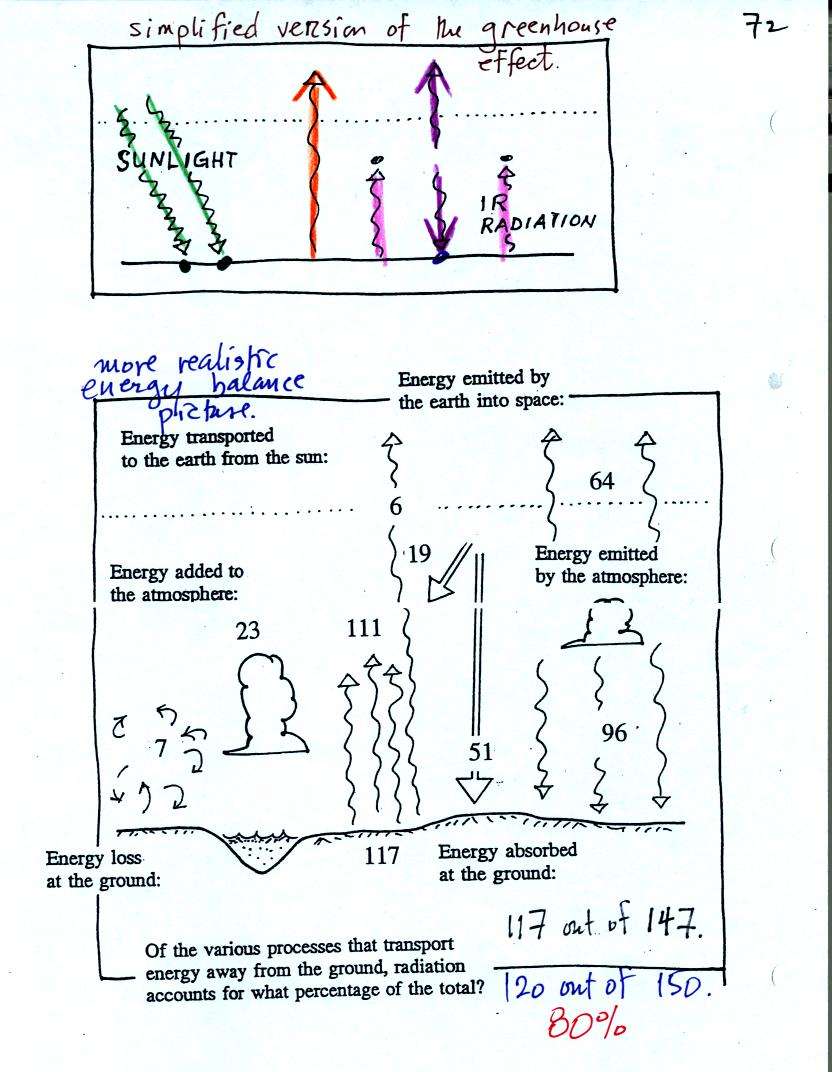
The lower part of the figure is pretty complicated. It would be
difficult to start with this figure and find the greenhouse effect in
it. However if you understand the upper figure, you should be
able to find and understand the corresponding parts in the lower figure.
We
will check the various parts of the complex figure to be sure they are
in energy balance. In doing this, a small piece at a time, you
should recognize and understand what is being illustrated. We
will start with the atmosphere.
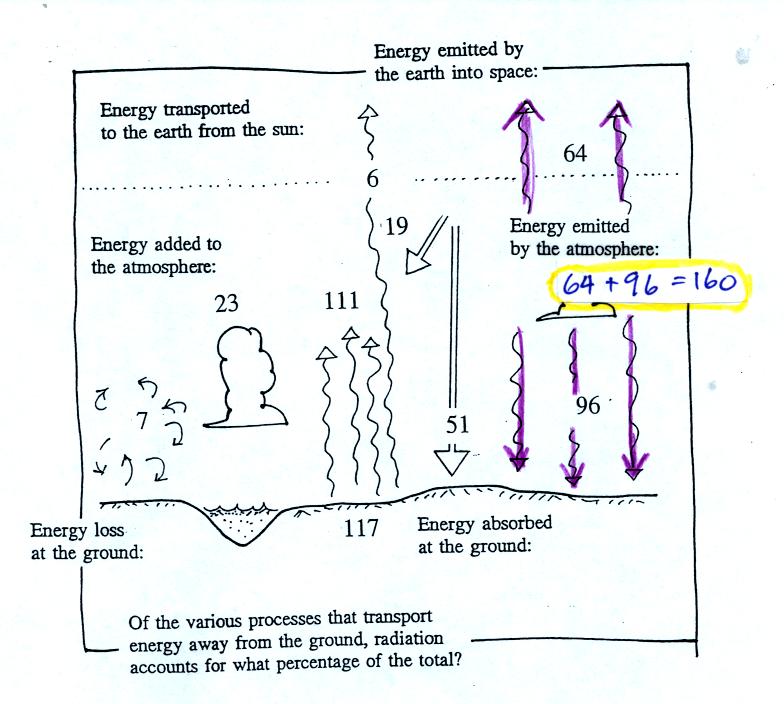
The atmosphere is emitting 160 units of energy. 64 units
go up and into space, 96 units go down and are absorbed by the
ground. How would you explain the difference between the amounts
being emitted upward and downward. One explanation might be
temperature. The upper atmosphere might be colder than the lower
atmosphere. Colder air would emit less EM radiation than warm
air. The upper atmosphere air density is lower than the lower
atmosphere air density. This might also explain the difference.
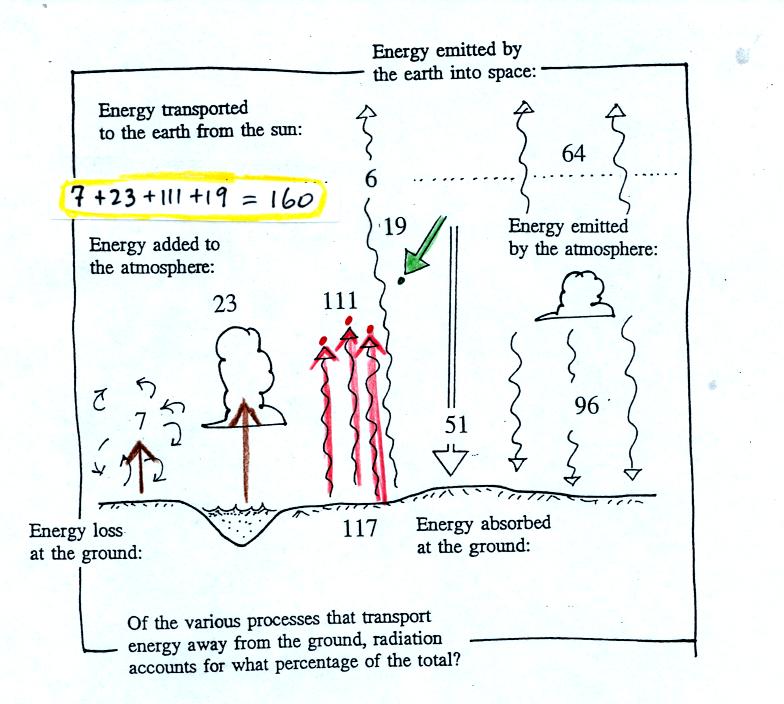
19 units of sunlight energy are being absorbed by the
atmosphere. 111 units of IR radiation emitted by the ground are
absorbed by the atmosphere. The 23 units at left is energy
transported in the form of latent heat (water in the lake evaporates,
heat is released into the atmosphere when the water vapor condenses and
forms the cloud). Together conduction and convection transport 7
units of energy from the ground to the atmosphere.
Next
energy loss and gain at the ground

The ground is absorbing 147 units of energy. Surprisingly
the ground gets almost twice as much energy (96 units) from the
atmosphere as it gets from the sun (51 units). This is partly due
to the fact that the sun is shining on any particular area for part of
the day while the atmosphere is emitting IR radiation downward toward
the ground all the time.

The ground is losing 147 units of energy, so everything is in
balance at the ground.
Next we'll
check energy arriving at the top of the atmosphere from space and
energy leaving the atmosphere and going back out into space.

The earth and atmosphere send 70 units out into space. This
is balanced by 70 units of sunlight arriving at the earth shown in the
figure below.

We're
almost done for today. We can use our simplified explanation of
the greenhouse effect to understand a couple more things.

The top figure shows energy balance on the earth with an
atmosphere containing greenhouse gases.
We modify the figure somewhat in the bottom picture. The incoming
sunlight has been removed; something that happens at night. The
ground is emitting 3 units of energy
and getting 1 back from the atmosphere. That is a net loss of 2
units. The ground will cool fairly rapidly during the night.

In the top figure it is still night but a layer of clouds
has been added. The clouds
are good absorbers of IR radiation even at wavelengths that would
otherwise pass through the atmosphere. If people were able to see
IR
light instead of visible light, clouds would appear black (that is why
the clouds were shaded grey in the figure) - it is
surprising how the appearance of something can change so dramatically
depending on the
kind of light you are able to see.
Clouds reduce the net loss
of energy at the ground. The ground still cools
but cools more slowly and doesn't get as cold during the night.
The bottom figure is a daytime figure (the green arrows of
sunlight are back in the picture ). The clouds will reflect some
of the incoming sunlight (this is what gives clouds their white
appearance) and
reduce the daytime high temperatures (you can tell it is cooler because
the ground is only emitting 2 arrows of IR energy).

Typical daytime highs and nighttime lows in Tucson for this
time of year. Note how the clouds reduce the daily range of
temperature.

The figure (p. 72c in the photocopied Class Notes) on the left shows
energy balance on the earth
without
an atmosphere or with an atmosphere that doesn't contain greenhouse
gases (so that IR energy emitted by the ground isn't absorbed by gases
in the atmosphere). The ground only needs to emit 2 units of
energy to reach energy balance. The ground wouldn't need to be
very warm to do this.
In the middle picture the natural greenhouse effect is in
operation. The ground is warmer and emitting 3 units of
energy. It can do this even though it is only getting 2 units of
energy from the sun because greenhouse gases absorb some of the emitted
energy and emit some of it back to the ground.
In the right figure the concentration of greenhouse gases has increased
(due to human activities). The ground has warmed even more
(global warming) and is now
emitting 4 units of energy and still only getting 2 from the sun.
But with more greenhouse gases, the atmosphere is now able to absorb 3
units of the IR emitted by the ground. The atmosphere sends 2
back to the ground and 1 up into space.
The next figure shows a common misconception about the cause of global
warming

Many people know that sunlight contains UV light and that
the ozone
absorbs much of the dangerous type of high energy radiation.
People also know that release of chemicals such as CFCs are destroying
stratospheric ozone and letting some of this UV light reach the
ground. That is all correct. They then conclude that it is
this additional UV energy that is causing the globe to warm. This
is not correct. There isn't much UV light in sunlight in the
first place and the small amount of additional UV light reaching the
ground won't be enough to cause global warming. It will cause
cataracts and skin cancer and those kinds of problems but not global
warming.



























